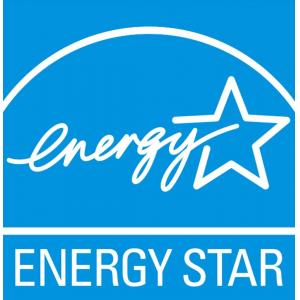

Add to Cart
About Energy Star Certified Energy Star
Energy Star is an energy saving program led by the US government
that focuses on consumer electronics. The ENERGY STAR program was
launched by the US Environmental Protection Agency (EPA) and the US
Department of Energy (DOE) in 1992 to reduce energy consumption and
greenhouse gas emissions. The plan was later adopted by Australia,
Canada, Japan, Taiwan, New Zealand and the European Union. The
program is voluntary, and Energy Star standards are typically
20-30% more energy efficient than US federal standards. The
earliest products that cooperated with this plan were mainly
computer and other information appliances, and then gradually
extended to motors, office equipment, lighting, home appliances and
so on. Later it also expanded to buildings. The EPA has actively
promoted the Energy Star Building Program since 1996. The EPA
assists voluntary participants in evaluating the energy use of
their buildings (including lighting, air conditioning, office
equipment, etc.) and planning the building The energy efficiency
improvement action plan and follow-up operation of the material, so
some homes or industrial buildings that introduce new environmental
protection concepts can also find the Energy Star logo.
Development status
A total of seven countries and regions around the world participate
in the ENERGY STAR program promoted by the US Environmental
Protection Agency, namely the United States, Canada, Japan, Taiwan,
Australia, New Zealand, and the European Union. Since 2001, an
international ENERGY STAR program meeting has been held annually.
There are now more than 30 categories of products included in this
certification, such as household appliances, heating / cooling
equipment, electronics, lighting products, etc. At present, the
most popular products in the Chinese market are lighting products,
including energy-saving lamps (CFL) , Lighting (RLF), traffic
lights and exit lights.
Applicable product range
Computers and office equipment: such as monitors, printers, fax
machines, copiers, all-in-ones, etc .;
Household appliances and similar household products: such as
refrigerators, air conditioners, washing machines, televisions,
video recorders, etc .
Heating and cooling equipment: heat pumps, boilers, central air
conditioners, etc .;
Large commercial buildings and new houses, doors and windows, etc
.;
Industrial and commercial products, such as transformers, power
supplies, etc .;
Lighting: such as domestic lamps;
Commercial food equipment: such as commercial ice cream machines,
commercial dishwashers, etc .;
Other commercial products: vending machines, access signs, etc.
Currently targeted products are: fluorescent lamps, decorative
string lights, LED lamps, power adapters, switching power supplies,
ceiling fan lights, consumer audiovisual products, battery charging
equipment, printers, household appliances and other various
products.
Test content
What ENERGY STAR includes:
Safety, EMI, surge, noise (non-energy star energy efficiency test
items) Light performance and energy efficiency test items:
1.Light effect and luminous flux
2.Color temperature, color deviation, color rendering index
3.Light intensity distribution, regional light flux distribution
4.Non-uniformity of chromaticity space
5, switching cycle
6.Lumen maintenance rate
7.Chroma maintenance rate
8.Size
9.Electrical parameters
